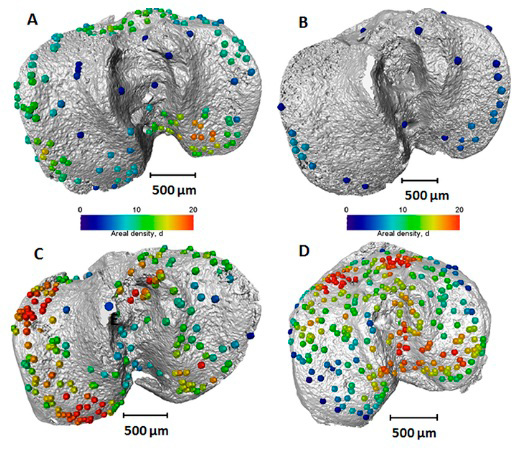RVC Skeletal Biology Group’s work showcased in the Diamond Light Source Annual Review Launch
Diamond Light Source, the UK’s national synchrotron science facility, launched its Annual Review last week at the Wellcome Trust, featuring work by Dr Katherine Staines and Prof. Andy Pitsillides of the RVC recently published in Arthritis & Rheumatology.
This event aimed to unveil the strategy for Diamond’s growth over the next decade through showcasing key publications from the past year. Diamond has approximately 9000 users/year and has enabled over 4800 peer reviewed papers. The selection of RVC work to be included in the annual review and in particular, at the launch event, is highly impressive.
In collaboration with scientists at the University of Manchester, Katherine and Andy are researching osteoarthritis (OA), a debilitating disease that is characterised by the loss of articular cartilage that normally covers the ends of bones to allow pain free movement. Using synchrotron X-ray microtomography on the Diamond Manchester Imaging Branchline (I13-2) they explored the properties of growth plate cartilage in the knees of arthritic mice. The detailed 3D scanning revealed that this tissue began to close prematurely by forming bony bridges across its length prior to the onset of disease. This bridging was excessive and was more common in areas in which the OA was at its most severe in the aged mouse. These results show an accelerated growth phenotype in the mice that could contribute to their disease pathology. The clustering of bony bridges found in late OA suggests that their formation is driven by mechanical factors, which gives the research team an important insight into how this disease progresses.

Katherine said: “Osteoarthritis is a debilitating disease affecting the vast majority of our ageing population. Our findings here are the first evidence for a link between abnormal growth, altered loads placed upon the joint and osteoarthritis development. This may allow us in the future to better identify those at risk of developing osteoarthritis and this will potentially enable us to prevent the progression of their disease.”
For further information on this and other research at Diamond Light Source see Diamond’s 2015/16 Annual Review
Research Reference
Staines et al., ARTHRITIS & RHEUMATOLOGY Vol. 68, No. 4, April 2016, pp 880–891 - www.ncbi.nlm.nih.gov/pubmed/26605758
Press Office Contact
Uche Graves / Zoe White
T: 0800 368 9520
E: uche.graves@plmr.co.uk / zoe.white@plmr.co.uk
Notes to Editors
The Royal Veterinary College (RVC) is the UK's largest and longest established independent veterinary school and is a constituent College of the University of London. The RVC offers undergraduate, postgraduate and CPD programmes in veterinary medicine, veterinary nursing and biological sciences, being ranked in the top 10 universities nationally for biosciences degrees. It is currently the only veterinary school in the world to hold full accreditation from AVMA, EAEVE, RCVS and AVBC.
A research-led institution, in the most recent Research Excellence Framework (REF2014) the RVC maintained its position as the top HEFCE funded veterinary focused research institution.
The RVC also provides animal owners and the veterinary profession with access to expert veterinary care and advice through its teaching hospitals; the Beaumont Sainsbury Animal Hospital in central London, the Queen Mother Hospital for Animals (Europe's largest small animal referral centre), the Equine Referral Hospital, and the Farm Animal Clinical Centre located at the Hertfordshire campus.
RVC Press Release 6 July 2016
See other Press Releases.
You may also be interested in:
-
A painful tail: RVC research reveals which dogs have greatest risk of a tail injury
A new study from the Royal Veterinary College (RVC) has found that the Boxer, English Springer …

